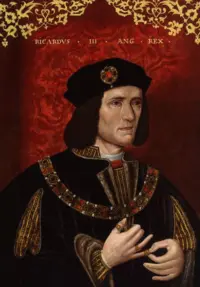kept Grant entertained until The Midget brought his tea. As he tidied the sheets together to put them away in his locker his hand came in contact with one that had slipped off his chest and had lain all the afternoon unnoticed on the counterpane. He picked it up and looked at it.

King Richard III
It was the portrait of a man dressed in the velvet cap and slashed doublet of the late fifteenth century. A man about thirty-five or thirty-six years old, lean and clean shaven. He wore a rich jewelled collar, and was in the act of putting a ring on the little finger of his right hand. But he was not looking at the ring. He was looking off into space.
Of all the portraits Grant had seen this afternoon this was the most individual. It was as if the artist had striven to put on canvas something that his talent was not sufficient to translate into paint. The expression in the eyes – that most arresting and individual expression – had defeated him. So had the mouth: he had not known how to make lips so thin and so wide look mobile, so the mouth was wooden and a failure. What he had best succeeded in was in the bone structure of the face: the strong cheekbones, the hollows below them, the chin too large for strength.
Grant paused in the act of turning the thing over, to consider the face a moment longer. A judge? A soldier? A prince? Someone used to great responsibility, and responsible in his authority. Someone too-conscientious. A worrier; perhaps a perfectionist. A man at ease in a large design, but anxious over details. A candidate for gastric ulcer. Someone, too, who had suffered ill-health as a child. He had that incommunicable, that indescribable look that childhood suffering leaves behind it; less positive than the look on a cripple's face, but as inescapable. This the artist had both understood and translated into terms of paint. The slight fullness of the lower eyelid, like a child that has slept too heavily; the texture of the skin; the old-man look in a young face.
He turned the portrait over to look for a caption.
On the back was printed: Richard the Third. From the portrait in the National Portrait Gallery. Artist Unknown.
Richard the Third.
So that was who it was. Richard the Third. Crouchback. The monster of nursery stories. The destroyer of innocence. A synonym for villainy.
He turned the paper over and looked again. Was that what the artist had tried to convey when he had painted those eyes? Had what he had seen in those eyes been the look of a man haunted?
He lay a long time looking at that face; at those extraordinary eyes. They were long eyes, set close under the brows; the brows slightly drawn in that worried, over-conscientious frown. At first glance they appeared to be peering; but as one looked one found that they were in fact withdrawn, almost absent-minded.
When The Midget came back for his tray he was still staring at the portrait.
1 comment